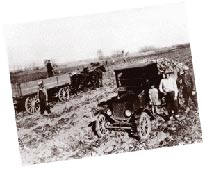- Reclamation
- Missouri Basin and Arkansas-Rio Grande-Texas Gulf
- Multimedia
- Lewis and Clark: In Their Own Words
Lewis and Clark: In Their Own Words
"By the time we actually got started making a sagebrush flat into a farm, we began to see the theory behind the old saying about Rome not being built in a day. The brush had to be chopped out with a grubbing hoe, piled and burnt; then the ground plowed and leveled, with all high spots removed and depressions filled in to allow the water a free flow. About that time, the water would find a soft spot in a new ditch, presenting us with a few gullies to laboriously fill and smooth up. We found we could put a lot of mileage on a small spot."

Pickling cucumbers at Squire-Dinge Plant in Newell, South Dakota, September 1930. Bureau of Reclamation photo
- Glen Vernam, pioneer in Frannie Division of Shoshone Project, Wyoming
"Had I not heard many times that Powell was the Garden Spot of the West? A garden spot to me meant roses, pink ones, and while I knew better, the picture called up by the phrase...lingered in my consciousness. When we arrived I thought someone had a funny idea of a garden spot."
- Mr. R.T. Baird, Shoshone Project pioneer
"I farm with my family. Our sons are the fourth generation of the family to irrigate the farm which was homesteaded by my husband's grandfather. The only reason I am able to earn a living in this beautiful but dry area, which has annual precipitation of about six inches, is because Buffalo Bill Dam was constructed to store the runoff."
- Beryl Churchill, Powell, Wyoming
The above quotations are from In the Shadow of the Rockies, by Sharon Kahin and Laurie Rufe, 1983, published by Northwest Community College, Powell, Wyoming
"The greatest hardship of all was the scarcity of water. The only water we had for any purpose was contained in a gallon jug, and we did not know how soon or where we could get more. Consequently, we drank sparingly and in little sips, and bathed our hands and faces in the dewy grass of the morning."
"The first settlers had dug wells, which eighty to ninety feet down were still dry as dust. At first we were filled with dismay to find no water anywhere. Sometimes we had none even to drink until Alec bought a barrel which he filled with water each day when in town."

Harvesting sugar beets on the Plunkett Farm near Chinook, Montana. Milk river Project, Montana 1929; (Bureau of Reclamation photo)
"My throat constricted with pain when I thought of the well that we had planned with which I meant to irrigate my lovely dream garden. It now seemed very remote indeed. Alec plowed a small plot for a garden and I attempted the disheartening task of planting it - disheartening because amid the hard, dry chunks of sod I could find no loose soil for covering the seeds."
" Patiently, I took up sods one by one, and with my hands pounded and shook soil from the matted grass roots and carefully patted it over my seeds. But disillusionment sat heavy upon me. As I worked the tears fell, and truly I 'watered my furrows with tears.' No more rains came, the grass shriveled and dried up, and shimmering heat waves danced around the landscape. My first garden on the homestead became only a sad memory."
- Pearl Price Robertson, Homestead Days in Montana, from The Last Best Place; A Montana Anthology, edited by William Kittredge and Annick Smith

